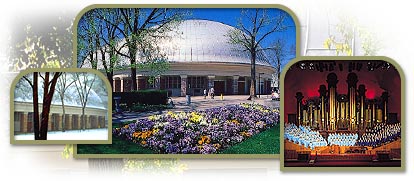Difference between revisions of "Tabernacle"
| Line 1: | Line 1: | ||
| − | [[image: Salt_Lake_Tabernacle_Mormon.jpg|350px|right|alt=Mormon Salt Lake Tabernacle|Mormon Salt Lake Tabernacle]]A '''tabernacle''' is a large multipurpose building. | + | [[image: Salt_Lake_Tabernacle_Mormon.jpg|350px|right|alt=Mormon Salt Lake Tabernacle|Mormon Salt Lake Tabernacle]]A '''tabernacle''' is a large multipurpose building. Within [http://comeuntochrist.org The Church of Jesus Christ of Latter-day Saints], a tabernacle refers to buildings constructed by the early [[Mormon Pioneers|Mormon pioneers]] as the center piece of a town. Most major Latter-day Saint pioneer towns have a tabernacle in their downtown area. There were seventy-nine tabernacles built in connection with Latter-day Saint settlements between 1850 and 1890. The largest and most famous is the Salt Lake Tabernacle located on [[Temple Square]]. |
==The Historical Value and Significance of Latter-day Saint Tabernacles== | ==The Historical Value and Significance of Latter-day Saint Tabernacles== | ||
| Line 5: | Line 5: | ||
During their travels in the wilderness, the people of Israel were commanded to build a tabernacle so that God could “dwell among them” (Exodus 29:46). “Tabernacle literally means ‘place of dwelling’ and was so called in the belief that God literally lived within its sacred confines. When Israel camped, the tabernacle was set up in the precise center of the camp (symbolizing the idea that God was to be the center of his people’s lives).”[https://www.churchofjesuschrist.org/study/ensign/2018/03/journey-through-the-ancient-tabernacle?lang=eng] For Latter-day Saints, [[Temples|temples]] are more in line with the biblical purpose of a tabernacle. | During their travels in the wilderness, the people of Israel were commanded to build a tabernacle so that God could “dwell among them” (Exodus 29:46). “Tabernacle literally means ‘place of dwelling’ and was so called in the belief that God literally lived within its sacred confines. When Israel camped, the tabernacle was set up in the precise center of the camp (symbolizing the idea that God was to be the center of his people’s lives).”[https://www.churchofjesuschrist.org/study/ensign/2018/03/journey-through-the-ancient-tabernacle?lang=eng] For Latter-day Saints, [[Temples|temples]] are more in line with the biblical purpose of a tabernacle. | ||
| − | Tabernacles built by early members of | + | Tabernacles built by early members of The Church of Jesus Christ of Latter-day Saints were places of religious and community significance. They were large religious and community gathering places. In some respects, community tabernacles, built and funded by members of the Church of Jesus Christ and its leadership, served as stake centers, although more architecturally ornate. They were used for meetings with several congregations combined. |
Tabernacles are larger than the tens of thousands of regular Latter-day Saint meetinghouses (or chapels) where Latter-day Saints meet weekly for Sunday services. They also differ from temples, which are sacred buildings reserved for faithful Latter-day Saints to worship and perform sacred ordinances. | Tabernacles are larger than the tens of thousands of regular Latter-day Saint meetinghouses (or chapels) where Latter-day Saints meet weekly for Sunday services. They also differ from temples, which are sacred buildings reserved for faithful Latter-day Saints to worship and perform sacred ordinances. | ||
Revision as of 15:02, 27 April 2024
A tabernacle is a large multipurpose building. Within The Church of Jesus Christ of Latter-day Saints, a tabernacle refers to buildings constructed by the early Mormon pioneers as the center piece of a town. Most major Latter-day Saint pioneer towns have a tabernacle in their downtown area. There were seventy-nine tabernacles built in connection with Latter-day Saint settlements between 1850 and 1890. The largest and most famous is the Salt Lake Tabernacle located on Temple Square.The Historical Value and Significance of Latter-day Saint Tabernacles
During their travels in the wilderness, the people of Israel were commanded to build a tabernacle so that God could “dwell among them” (Exodus 29:46). “Tabernacle literally means ‘place of dwelling’ and was so called in the belief that God literally lived within its sacred confines. When Israel camped, the tabernacle was set up in the precise center of the camp (symbolizing the idea that God was to be the center of his people’s lives).”[1] For Latter-day Saints, temples are more in line with the biblical purpose of a tabernacle.
Tabernacles built by early members of The Church of Jesus Christ of Latter-day Saints were places of religious and community significance. They were large religious and community gathering places. In some respects, community tabernacles, built and funded by members of the Church of Jesus Christ and its leadership, served as stake centers, although more architecturally ornate. They were used for meetings with several congregations combined.
Tabernacles are larger than the tens of thousands of regular Latter-day Saint meetinghouses (or chapels) where Latter-day Saints meet weekly for Sunday services. They also differ from temples, which are sacred buildings reserved for faithful Latter-day Saints to worship and perform sacred ordinances.
Historically, tabernacles have ranged from simple log cabins (Kanesville, Iowa, constructed in 1847) or adobe (mud brick) buildings (the first tabernacle in Salt Lake City, Utah, 1852) to classically inspired temple-like structures (Bountiful, Utah, 1857–63, Logan, Utah, 1864–91), picturesque Victorian halls (Bear Lake (Paris), Idaho, 1884–89, and Provo, Utah, 1883–96), and buildings that hark back to the American colonies (Boise, Idaho, 1924–25). The last tabernacle built by the Church was the Ogden Pioneer Tabernacle. Of steel and concrete, it featured modern international architecture (1952–56).
Due to popularity, the Salt Lake Tabernacle is often referred to as simply "The Tabernacle" and is often the location where the the Tabernacle Choir at Temple Square performs and rehearses. Other tabernacles have seen their purposes change. For instance, the Vernal Tabernacle was converted to the Vernal Utah Temple, and after the fire that destroyed much of the Provo Tabernacle, it was rebuilt and expanded into the Provo City Center Temple. Several, such as the Bountiful Tabernacle, the Rexburg Tabernacle, and the Heber Valley Tabernacle, are no longer owned by the Church of Jesus Christ and are used for other purposes.
